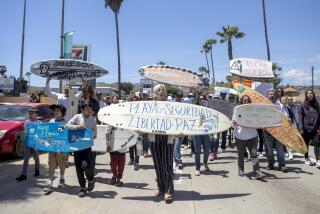Aussies Want to Recapture Spirit of ’83
- Share via
SAN DIEGO — September 26, 1983. A day that will live in infamy in Australia.
That was the day 132 years of sailing tradition was trashed, discarded in Newport, R.I., in the seventh and final leg of a yacht race that rocked the world. That was the day the America’s Cup, which until then held little interest outside the yachting world, was torn from America’s vice-like grip and thrust into Australia’s eagerly awaiting one.
“There’s probably not an adult in particular, male or female, that can’t tell you where they were on Sept. 26, 1983, at 7:10 a.m.,” said Rob Mundle, an Australian journalist. “That’s when everyone in Australia immediately became a yachting expert. The public awareness of the America’s Cup in Australia is very, very high.”
So are the aspirations of the two syndicate heads who hope to win back the Cup for Australia--Dennis Conner returned it to America in 1987--when the world’s premier regatta, the America’s Cup competition, heats up in 1992.
Iain Murray, who has nurtured his Spirit of Australia challenge from its infancy four years ago and even formed a new yacht club to do it, has come up shorthanded in the two previous times he’s played this America’s Cup game. He doesn’t foresee a third.
“I’ve been there before, I’ve been second,” Murray said recently. “It’s not like I want to do that again. We have one thing to do. You can blow different words at it, but we’re here because we want to win and not for any other reason. They say life’s not a dress rehearsal. There is no second place.”
If Australia is to take home the America’s Cup, it would be a momentous occasion. But would it equal the impact and cause the elation it did nine years and a thousand yacht races ago?
“I think there would (the same excitement), possibly more,” Murray said. “People understand it a bit more and they understand the odds we’re up against this time. And the country’s looking for something to hang its hat on.”
According to Mundle, the Australian recession is “worse then it is here,” and spirits would be lifted by an Aussie victory. Unemployment in Australia has surged to 10 1/2%, and the economy is at its worst since the 1930s.
“They want a light at the end of the tunnel,” he said. “They remember the euphoria associated with winning in ’83 and they need that again, to unite the country. If we win, the world will be the party.”
Murray’s Australian rival, Challenge Australia, led by feisty hotelier Syd Fischer, said his countrymen have high hopes, indeed, but none of which are pinned on his crew. Fischer feels his syndicate is viewed as a second-class citizen at home and is recognized as a legitimate threat only outside the Australian borders.
“In general, I think Australians think it can be done again,” Fischer said. “And I think they probably expect too much. They expect (Australia) to do it again, but they’re probably not expecting us to do it.”
Fischer said Challenge Australia has been “denigrated by the Australian press,” and holds Mundle somewhat responsible. Mundle, a leading yacht writer in Australia, was the publicity director for Spirit of Australia until earlier this week.
“One of the media moguls is sponsoring Murray. They’ve made sure our press is bad,” Fischer said. “I don’t think people know how difficult it is to combat some of these other syndicates and the way they’re run. But it’s not impossible.”
A perfect pay-back, Fischer said, would be for Challenge Australia to sail away with the challenger trials. “It makes you more bloody determined,” he said. “It gets up my nose a bit, but I just think ‘stuff ‘em, go beat them, that will shut them up.’ ”
Murray and Fischer weren’t always on competing sides. In 1983, the skipper of Fischer’s first Cup yacht, Advance, was Murray, who was entering his first America’s Cup race as well.
Fischer described their current relationship as “standoffish. We talk to one another but I don’t imagine we’d go out to the pub and have beers. But that doesn’t matter. We take it for granted we have to beat them as much as we have to beat any other challenging syndicate to get into the final and meet the Americans.”
Murray was more generous in his assessment of their relationship, but agreed on the competition clause.
“Syd’s a competitor,” he said. “He’s like one of how many competitors we’re going to have to race in the end. But he’s also an Australian that has contributed greatly to yachting in our country and I respect him a great deal for that. I learned a lot from Syd in 1982 and ‘83, but likewise from Alan Bond and John Bertrand and the guys that won.”
Neither won in 1987, but Murray, skipper of Kookaburra III, came closest. Fischer, in Steak ‘n Kidney, discovered his boat was fitted with the wrong keel late in the defender trials and lost the series to Kookaburra III, which lost to Stars & Stripes in four consecutive races in the finals.
While there are contrasts in the campaigns both men run--Murray calls his effort “people-powered,” and Fischer’s is a self-made operation--similarities abound. Both syndicates have a one-boat campaign, operate on a shoestring budget, are technologically up to speed and believe in a hard’s day work. The also think that the America’s Cup is a financial hand grenade about to explode.
Neither would divulge their budgets, but a peek at their respective base camps suggests a limited window of spending.
“It’s like taking a burro to a polo race,” said Bruce De Mers, owner of the Blue Crab restaurant, which feeds the Challenge Australia crew three times a day. “Next door you have America-3 with probably 160 people and 60 automobiles. These guys have one car and the rest ride bikes.”
Fischer said, “Over here, you have about 1,500 hurdles to jump before you get anywhere,” and that bureaucratic red tape is more a problem than personnel.
“We have a pretty good support team,” he said. “If I put more people on here, they’d make more work for each other, then they’d shuffle paper around, then we’d just have more paper, more shuffling, and they wouldn’t get any better. Then we’d call it government.”
Chris Haver, director of syndicate operations for Knight & Carver Yacht Center, said Spirit of Australia set up camp quite unlike the Japanese, French and Italian syndicates, who are housed nearby.
“The Italians brought 100 cases of Dom Perignon and the boat, in that order. They had to make sure the champagne was secured, then the boat,” Haver said. “(Spirit of Australia crewmen) didn’t hire any of the general contractors or electricians you normally do. They did almost all of it themselves. The guys who are out grinding on race day are out here laying bricks the same afternoon. If that’s any indication of their work ethic in terms of their sailing, then I’m impressed.”
Both syndicates have respected boat designers. Murray leads his own design team, and Challenge Australia’s designer is Peter van Oossanen, a leader in the field.
“The Australians are clever inventors,” said Bill Trenkle, a member of Team Dennis Conner who has rubbed sailing shoulders with Murray and Fischer for years. “They won one race (‘83) and almost won another one (‘87). It was obvious at that point that they had made the proper advances.”
In pinpointing their strengths, Trenkle applauded Murray’s works in rule development and said Oossanen operates the most scientific of programs.
“This is a technology race as much as a boat race,” Fischer acknowledges.
Murray said a lesson learned in the last Cup outing hammered home the concept that technology’s role can’t be discounted.
“The biggest lesson we learned when we lost last time,” Murray said, “is the research and development plays such an almighty part. It can’t be underestimated or undertaken by one individual or even two. You needs the ideas and thoughts of many people from many areas.”
But technology doesn’t always work the way it’s supposed to. In 1983, Advance was a radical design, “but it turned out to be a really slow boat,” Trenkle said. So slow that the crew painted the bow of the boat black and threw dog biscuits as it came into the harbor.
“It was a real dog,” Fischer said with a laugh. “Here doggie, doggie, here doggie.”
Neither Murray nor Fischer find amusement in the financial stakes of the America’s Cup. Fischer suggests a two-boat limit for each syndicate; Murray like the idea of across-the-board funding cuts.
“If you look at this in perspective, even four years ago, you would never have believed anyone would be spending $100 million on a campaign,” Fischer said. “The more competitive it’s gotten, the more big bucks are being thrown at it. I can’t believe it. In my opinion, it doesn’t need to be spent.
“It hasn’t always been a money race. Syndicates had one boat and that was it. I’m not advocating one boat, but maybe two.”
Said Murray: “It’s a very hard thing to police, but what needs to be brought into context is how much money people can spend. We might need a salary cap or something like this. If the America’s Cup goes to the person who spends the most money, that’s a very sad day.”
Money was the root of a misunderstanding between Murray and Fischer that still hasn’t been clarified. It was reported in October that Fischer offered to take over Spirit of Australia, which was experiencing financial difficulty.
“Absorb, we offered to absorb them at one point,” Fischer said. “They were crying poor mouth, then when we made our offer and suddenly they found some money, they said that’s not what we meant. It didn’t receive favorable response.”
But Murray said he never heard from Fischer.
“I read a newspaper article about that, but I never spoke with him or received any correspondence from him or his challenging yacht club. I don’t think that a newspaper article is an offer.
“We never thought to join forces. Our problem is we made a commitment to all our sponsors. That clearly was something quite different from what Syd was doing. I don’t know why there was that statement in the paper. We didn’t need absorbing. We were after assistance, not a takeover.”
If, once the challenger trials are over and an Australian syndicate is still in the running, could they forget their differences and join forces for the sake of national pride?
“If one of these groups shows greater strength than the other, I would like to see the boat that continues along get the full support of the other group,” Murray said. “In many ways, I think we’re better off running our own race and bringing in that extra strength in at the end, when it’s needed. It’s a nice thought. Our side could do it.”
And Syd?
Better wait and see what happens in the trials.
More to Read
Sign up for The Wild
We’ll help you find the best places to hike, bike and run, as well as the perfect silent spots for meditation and yoga.
You may occasionally receive promotional content from the Los Angeles Times.






